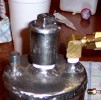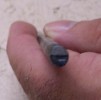Wax Injector
Wax Injector
Building A Wax Injector
I have tried to inject molds with wax by hand using a syringe with varying degrees of success. There were problems with keeping a constant pressure on the wax during the injection and issues with the molds I was trying to use. I would not have called the attempt a failure but it was a learning experience. Afterwards though, I thought I would be better off with a regular wax injector. My first thing to do was scrounge the Internet to find some plans. The plans I found by Alan Lewis were available on a few web sites. You will find them elsewhere on this site as well.
With plans in hand and a part list I set off to get the stuff to make it. Then came the road block. I could not find any three inch copper pipe anywhere close to where I live. In case your curious, I live in rural TN just east of the Tennessee River. After about a week of looking I gave up. Then I had the idea, why did it have to be copper or brass? Why couldn't it use steel pipe? So with that attitude I called up my local metal working shop and asked them to weld me up the main injector tank.
The main injector tank is made with 4" steel pipe 4" long with 1/4" plate steel welded to both top and bottom. Then the tank has three holes drilled in the top for a piece of 3/4" nipple and two 3/8" nipple welded in place for the pressure release valve, pressure gauge and fill cap and tire valve. Finally a piece of 3/4" nipple was welded to the side to take the injector valve. See pictures below. (You can click on the image for a bit of a larger view.)
The images above were as I received it from the weld shop. I would have made the piece myself but I do not own a welder to do the work. If you're capable of doing the work yourself I am sure you can save a few dollars on the project. One thing to note. I asked them for 3/8" nipple for the small pipe on top, but I would have been better off with 1/4" nipple. My pressure gauge is that size. Oh well, I guess I will just use a reducer if I can find them in that size. One other thing to note, the 3/4" nipple that will serve as the connection place for the injector has a 3/4" hole all the way through into the tank. I will have to use an external spring injector nozzle because there is no place for the spring to rest internally.
Now with the main body made I can continue with the construction of the wax injector. I have decided that instead of using a pop off valve, I will replace it with a pressure regulator. I elected to do this because I could not find a pop off valve locally that would pop at 30 p.s.i.. Additionally, I will use a pressure gauge just as a check and to use it to dial in the regulator. Finally I will use the 3/4" nipple on the top for a fill hole only.
The first order of operation was to attach the pressure regulator to the tank. This step only came first because of the limited room available on the tank top. The image on the left shows the components that make up the pressure regulator. These are an elbow, the regulator itself and a air hose fitting. The picture on the right shows the pieces attached to the tank.
The first three pictures above are of the pipe coupler and fill cap. The fill plug is made from a length of 3/4" threaded pipe coupler and a pipe plug. The shoulder was made by threading the plug into a washer and then tack welding it into place. I will cut a washer from neoprene gasket material to seal it. Finally, the last image shows the hardware attached to the injector tank.
The image on the left shows the 30 p.s.i. gauge and the hardware needed to reduce the 3/8" nipple down to 1/4". The last picture shows the gauge attached to the tank.
WHEW, I am getting there. Now all that is left is to machine the injector.
The actual injector turned out to be a project in itself. Never having machined anything in my life, I was faced with the learning curve of how to use my lathe and set up it's tooling. My first attempt was to turn down some CRS 1/4" round stock. I used a pair of calipers and measured the ID of the 1/4" pipe nipple. My calipers read roughly 7/32". I thought I would just take a couple of very light cuts on the CRS so that it would pass freely inside the nipple. To make a long story short, I had to take a few passes of the CRS just to get it round from my poor centering job and by the time I finished it, it slipped through the nipple just fine. The problem was it had way too much play. Looked like I was back at the start again.
For my second attempt, I thought I would take a different approach. This time I decided it would be easier to fit the pipe nipple to the outside diameter of the CRS. To do this I knew I would need a fairly close fit. I thought a reamer would do that for me. The problem I faced was that I didn't have a reamer. The good news was that I read in a Gingery Book how to make a simple reamer to ream soft metals with like Aluminum and Brass. I took a piece of 1/4" CRS and ground a flat on the side of it for about half it's diameter. See the picture below.
Next, I chucked a piece if 1/4" CRS in the lathe and run a piece of emery cloth over it until I had a good free sliding fit without much play. Next, I needed to bore a hole through the rod that I just sanded down. I took my centering square and made some marks on it to find the center. (Well, let's just say that I still need to learn the knack of centering.) With the piece chucked back into the three jaw chuck of my lathe, I attempted to drill the hole with the tail stock and a Jacobs chuck. Needless to say, my centering job affected the end product. The hole was a little off center. Not too bad that it could not be used though. I drilled about an inch deep and realized that my bit would not be long enough. But I figured I had a 1" or so deep hole drilled into the length of the piece and that I probably could finish the job with a hand drill.
Next I clamped the piece in the vice and started to drill its length with a long bit I bought from Lowes. By the way, the hole diameter I was drilling was 1/8". I have no idea what the hole size should be and I guess I will find out if it worked when I try the thing out. After drilling about three or so inches into the piece, I went ahead and cut it off. The first thing I noticed was that my hole had wondered very close to the edge. Hmmmm.... I guess hand drilling isn't that easy even with a starting hole or my starting cut was off that much. Oh well, I decided it would work.
At this point I decided that I would just use a piece of CRS round stock as a stop on the back of the injector. I punched a center mark in the piece and drilled a hole a little ways in to tap it for 1/4" x 20 threads. After drilling the hole, I tapped and cut it off the stock. Next I used a die to cut threads on the end of the injector that had the hole very close to the edge. The threads cut through the side of the hole, but I figured it would be screwed into the stop and not affect the usefulness of the injector. Finally, I cut a piece of neoprene gasket material to make a gasket that would seal the inside surface of the injector nozzle and drilled a 1/16" hole through it's diameter. This hole is to allow the melted wax to enter the injector nozzle. See below for the progress so far.
I was starting to get excited about the project now. I was getting close to finishing the injector. As you recall, there was the problem of not having a spot for the spring to rest for an internally sprung injector. I knew that I would have to place the spring outside. All that was left was to make a set screw collar to sit on the outside that would retain the spring. I used the same CRS stock that I used to make the internal stop. I drilled a 1/4" hole through it and then run my homemade reamer through it for a good sliding fit on the injector. Next I drilled a hole through the side of the collar to accept a tap for 1/4" x 20 threads for a set screw. Now the injector nozzle is finished for the most part. See the pictures below for the finished and assembled injector and it installed on the injector tank. After looking at it a while, I think I may need to thread the end of the injector and make a larger nozzle for it. If I do this, I will do away with the set screw collar and just use the nozzle end to hold the spring. It depends on how well it works for injecting the wax.
Lastly, below is a finished picture of the complete wax injector. There may be a few more things I will want to do to finish this project up. For example, a larger nozzle on the end of the injector and a thermometer would also be good to let me know how hot the wax is. I am going to order some injection wax and give it a try. I will post pictures of that process here as well. After all, a project is not quite finished until you use it in the real world.





















